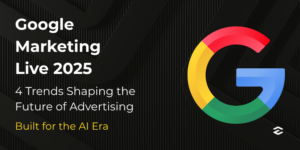
Google Marketing Live 2025: 4 Trends Advertisers Must Know
Google is doubling down on AI-first advertising strategies in 2025. Here are the four trends from Google Marketing Live that advertisers must act on.

For advertisers and consumers alike, 2023 was the year of artificial intelligence (AI). From ChatGPT to Midjourney, popular AI tools have transformed how we think, work and create.
Perhaps the most disruptive AI-powered tool to launch in 2023, the beta version of Google’s Search Generative Experience (SGE) summarizes relevant links and answers to search queries.
In some cases, SGE results displace search ads or make them less visible, posing a potential problem for advertisers. But this search trend doesn’t signal the end of paid search. Instead, think of it as another opportunity for advertisers to leverage new tools in this ever-changing industry.
Once SGE becomes available to the general public, advertisers may see a massive shift in how users interact with search engines. In this article, we’ll explore what these changes could mean for the future of search engine advertising.
The good news is that as of January 2024, the average Google user isn’t seeing any dramatic changes to their search experience. SGE is still in beta, so only a limited number of users can see the AI-generated search results.
On top of that, users have to toggle on the search generative feature to see the AI snapshot. And some users distrust SGE results or find them less refined than standard search results.
So, advertisers don’t need to worry just yet about implementing a new strategy. Yet we should start learning about this new feature and how it could impact search advertising.
Prior to the launch of SGE, users would typically see ads at the top of their search results. Search ads have long allowed advertisers to position themselves above organic SEO-optimized results. For more than a decade, paid search has been a foolproof way for advertisers to get in front of high-intent audiences and corral them into the sales funnel efficiently.
Now, users who have enabled SGE may see search ads before or after AI-powered results. As a result, ads may be less visible for some searches.
Next, Google intends to experiment with incorporating search and shopping ads into both the AI-powered snapshot and the conversation interface. For advertisers, this opens up a potential new placement option, making increased impression share a distinct possibility.
How does the conversation component work? In addition to viewing the initial AI-powered search snapshot, users can ask a follow-up question and generate another AI-powered response. It essentially creates a chat-based search experience directly on the search engine results page.
But until these new features are widely available, there are many steps advertisers can take to prepare their accounts and clients for these changes.
The generative search experience is one of the biggest changes we’ve seen in search advertising in a long time. While it may have some downsides, it could also benefit advertisers.
Using the power of AI is hardly a new concept for advertisers. Take Smart Bidding and Performance Max, for example. AI-powered automation as just one lever advertisers can pull to improve efficiency.
SGE may give advertisers more opportunities to get in front of the most relevant and highest converting audiences. Since users can now ask hyper-specific questions, advertisers can now create hyper-specific search ads that wouldn’t have been possible before.
When most advertisers develop search campaigns, keyword research can only tell us so much about the search terms most likely to resonate with the target audience.
With SGE, advertisers can get a closer look at the direct thought process a potential buyer goes through when our ads serve to them. In other words, advertisers can leverage conversational long-tail keywords.
Developing ads for Google’s “ask a follow-up” feature may also help advertisers target even more intentional and specific audiences. It could be a great way for Google to allow advertisers to talk to the most relevant and engaged audiences.
At the moment, there’s no confirmation that Google will give advertisers access to audience segments based on those who use SGE or the “ask a follow-up” feature. Just the possibility is an exciting prospect.
As of January 2024, Google hasn’t shared a timeline for rolling SGE out to the general public. But that doesn’t mean now isn’t the time to prepare. To come out ahead of the competition, advertisers should have tactics ready for when this new search experience does go live.
First and foremost, clients should audit their SEO efforts. It’s likely that these rankings will determine whether or not a website displays in the generative search experience.
Ads will still appear above, below and sometimes within the generative search experience. But it’s likely that most users won’t make it past the SGE snapshot if they have the option toggled on.
As a result, SGE may increase the likelihood of zero-click searches. In other words, having a high-ranking, SEO-optimized website is more important than ever.
SEO-optimized websites and content will have a greater chance of populating in the generative search experience organically. This is important because the generative experience pulls snippets from featured websites, making it easy for users to get the necessary info without clicking.
In addition to a decrease in clicks, with Google generating top results, advertisers should prepare clients to see a decline in search volume in general.
The rollout of SGE is more than just the usual algorithm updates we’re used to seeing. Instead, it’s changing the search experience to an extent we’ve never seen before.
To experience SGE for yourself, join the beta. Run your search terms through it to see where your website ranks, and make applicable changes to your SEO strategy.
Note how search ads deliver in the generative search experience for your highest performing keywords. Do they display above, below, or within the SGE snapshot?
Experiment with the “ask a follow-up” feature for your highest performing keywords. Consider incorporating some of these long-tail keywords into your paid search campaigns.
If you aren’t running programs on other platforms or channels and want to have a preliminary plan for when this new feature rolls out, now is the time to get started.

Google is doubling down on AI-first advertising strategies in 2025. Here are the four trends from Google Marketing Live that advertisers must act on.

Closed Loop and Clover earned three Silver Telly Awards for the “Behind the Business” campaign, celebrating standout creative across CTV and digital.

Learn how leading CMOs are reframing marketing to speak the CFO’s language, drive predictable outcomes, and secure their budgets in 2025 and beyond.